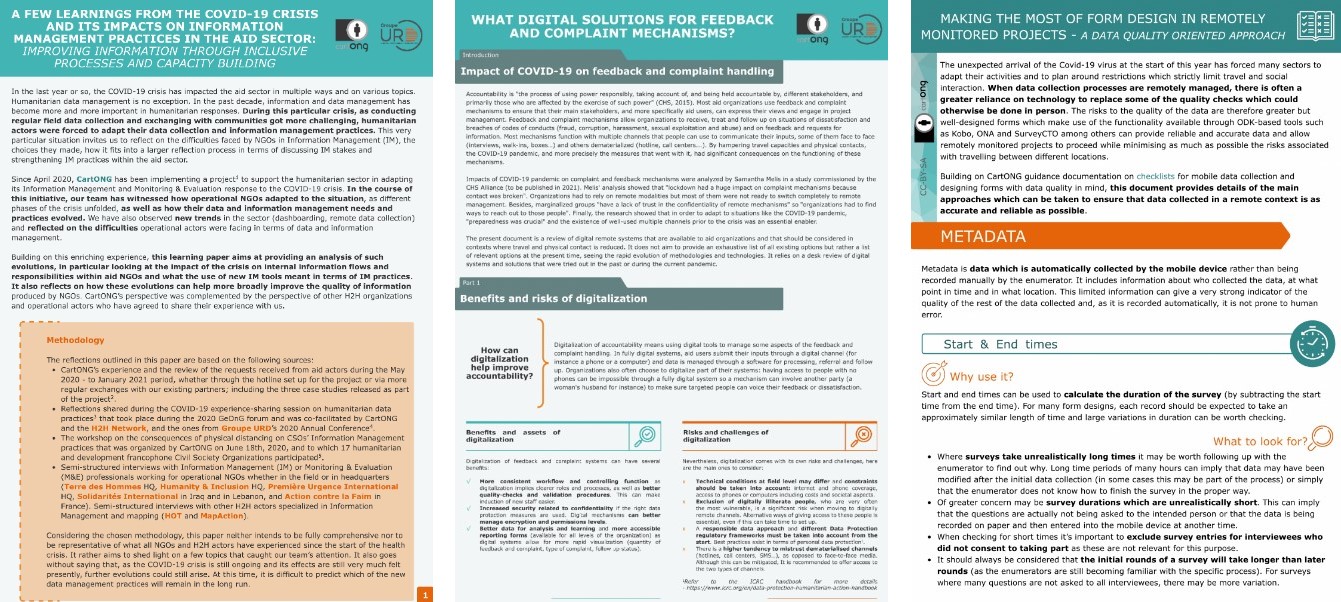Supporting NGOs in adapting their Information Management and MEAL systems to the Covid-19 crisis

Photo: CartONG
CartONG, is a French H2H NGO specializing in Information Management that aims to put data at the service of humanitarian and development projects. CartONG is dedicated to improving the quality and accountability of field activities, in particular through better needs assessments and M&E. It acts as a multidisciplinary resource and expertise center, supporting NGOs’ strategies and operations.
Supporting NGOs in adapting their Information Management and MEAL systems to the Covid-19 crisis: the importance of collaboration and long-term support
At the beginning of the Covid-19 pandemic, the humanitarian sector rapidly realized that remote working and physical distancing would pose serious challenges for information management. CartONG observed the changes required in the way data was used and managed within the aid sector, and saw the opportunity to support NGOs in adapting their response to the ongoing crisis.
To build on these initial insights, we conducted a workshop with civil society organizations. Findings highlight the need for organizational adjustments and optimization of tools to cope with the overall lack of technical preparation as well as the need to adapt information management and monitoring and evaluation activities to cope with the increasing complexity of relationships with beneficiaries.
“Many thanks for your support which allowed us to roll out a Covid-19 tracking dashboard much sooner than we anticipated.”
(Anonymous quote from the project satisfaction survey)
The Covid-19 IM Help Center
CartONG thus set up a Covid-19 IM Help Center for the duration of the project (May 2020 to January 2021). The Help Center provided pro bono direct support to organizations, in particular via a dedicated hotline and via coaching sessions. Typical requests included how to adapt mobile data collection questionnaires to remotely managed surveys, as well as how to create dashboards or dynamic maps. In total, 19 local, national and international organizations benefitted from CartONG’s direct support.
As part of the Help Center, CartONG also conducted online capacity building events and training for over 190 people, aiming to support new ways of collecting and managing data while working remotely.
In addition, CartONG wanted to improve the overall efficiency of information management in the humanitarian sector by producing resources that could be used widely. In total, 14 guidance resources were published (including 8 also translated in French), all available on our blog. To date, these resources have been consulted over 3,300 times. To ensure appropriation of these resources by operational NGOs, it was important to keep them as practical as possible, and so they include several ready-to-use guidance documents, simple benchmarks for tools, as well as case studies.

A collaborative approach
It is important to note that CartONG worked with other H2H Network members to provide support – we were not alone! From the outset, collaboration with Groupe URD was established in order to combine skill sets. As part of this partnership, three practical guides were published (for example, guidance on tools for digital CRM mechanisms). A joint geospatial response was established with HOT and MapAction to formalize collaboration and to ensure rapid implementation when needed. Additionally, we were able to release a joint guidance on mapping. Together with Translators without Borders, CartONG published 20+ language tips for effective humanitarian data collection. This collaborative and complementary approach helped improve the quality and relevance of support provided.
Overall, CartONG received positive feedback from the organizations supported, whether through direct support, capacity-building events, or online resources. Ninety-two per cent of respondents to our ‘satisfaction survey’ mentioned that the support from CartONG fully met their needs, and 75% were fully able to overcome their difficulties.
“Please continue with this type of initiative. There is a real need for support in the sector.”
(Anonymous quote from the project satisfaction survey)
Conclusions and lessons learnt
A major challenge was around the dissemination of CartONG’s humanitarian-to-humanitarian support. However, the H2H Network-funded project provided a good opportunity to build visibility, develop new collaborative activities and generate interest in information management topics such as responsible data use (sometimes overlooked by NGOs).
We learned that it was not easy to support organizations during major crises. Most often, requests were unclearly defined. While there were clear gaps and difficulties to overcome, NGOs were not always able to identify the exact type of support they needed. Fortunately, CartONG was available to work with them and make proactive suggestions. However, this required significant investment of time and human resources – especially where, on further reflection, it emerged that the NGO in question required long-term support related to structuring information management systems and processes rather than one-off support with crisis response. At CartONG, we tend to attribute this fact to the limited maturity of the humanitarian information sector in terms of structure and data literacy, especially in small to medium international, national and local NGOs.
Further, CartONG concluded that this may have prevented some organizations from formalizing their needs and reaching out for support. We had to intensify and diversify our outreach strategy through not only relying on the Help Center that was set up at the beginning of the initiative but also by networking more widely and reaching out via other dedicated information management fora.
Beyond the Covid-19 crisis, providing longer term, tailored information management support and continuing to build general data literacy in the humanitarian sector remains a priority issue that will require commitment of H2H organizations who specialize in information management, but also the wider H2H community as well as supportive donors.
Sign up to our newsletter
The latest H2H Network news, impact stories and resources, sent straight to your inbox every month.